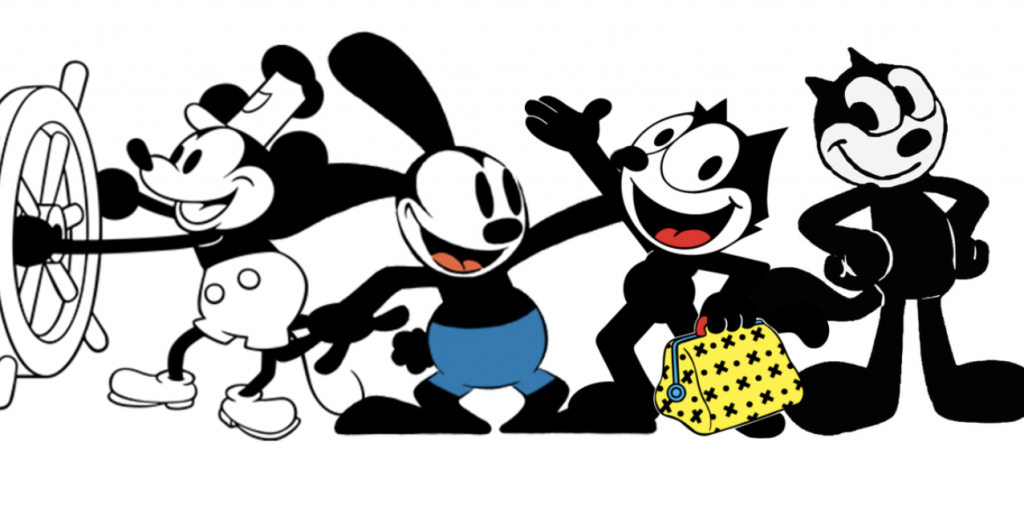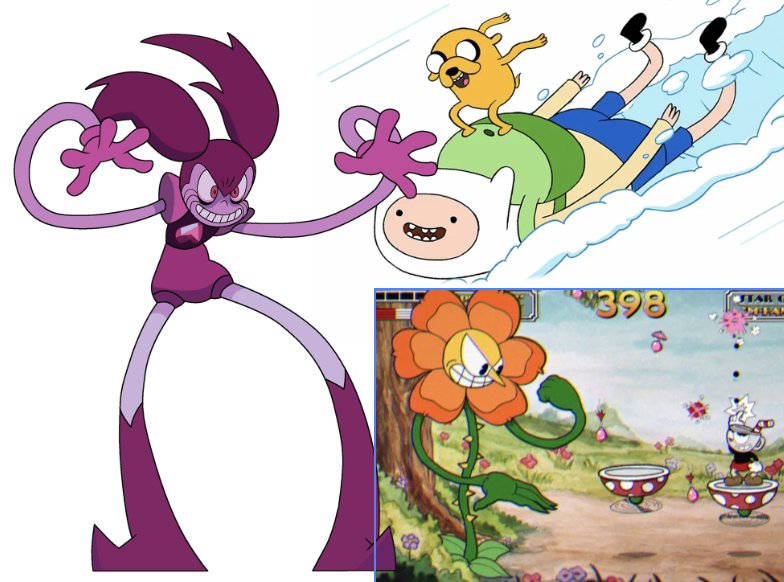Character Movement in the Rubber Hose Animation
Yiwei Lu

The fluid motion in the rubber hose animation attracts me. By analysing its rise and fall, I hope I can learn something to refine my own practice.
Rise
During the silent era of American animation, the 1920s marked the rise of rubber hose animation. Restricted by the techniques at that time, early animations barely had plot. Instead, most cartoons relied on the musical gags (Merritt and Kaufman,1992), influenced by silent films and Jazz.

A defining feature of rubber hose animation is its flexible and smooth motion cycle: objects move fluidly in curving motions, much like the rubber hose. That ‘funny fast-paced sequence can enhance gags well (Merritt and Kaufman,1992). The performances of Charlie Chaplin and Buster Keaton gave a good reference for this style (Crafton, 1982). Built on their influences, the rubber hose animation can make the performance more exaggerated by stretching the characters’ bodies without limit. Film historian, William Paul, observed that, ‘Animation provides a total control that is closer to music than to live-action films.’ (1970). From ‘The Skeleton Dance’ and ‘Betty Boop’s Snow White‘, this surreal style worked jointly with the music and brought the strong impression.
The rubber hose animation was applied widespread in the American animation industry is not only due to the culture influence, but also because its repeated action and motion cycles really saves the labor cost (Merritt and Kaufman,1992).
Decline
Without any foundation in anatomy and musculature, the rubber hose animation lacked the realism. The repeated and exaggerated movement restricted the narrative development and the character depth (Merritt and Kaufman,1992). Additionally, as the the rubber hose animation became increasingly industrialised (Pallant, 2011), characters like Oswald the Rabbit, Felix the Cat, Mickey Mouse etc. look and move in the similar way.

When audiences watched too many cartoons that composed by unrelated gags, they complain that ‘There is too much repetition of action’ (Merritt and Kaufman,1992). Audiences’ expectations and developed techniques leaded the whole animation industry to the narrative animation which was more sophisticated (Pallant, 2013). Just like ‘Snow White’ and ‘Bambi’, which made the Disney Studio become more remarkable. The new approach also marked the decline of the rubber hose animation.
Revival
Although the rubber hose animation faded from the screen, it was never abandoned. Its signature feature – the exaggerated movement, the curving motion, stretch and bend- can still be found in later Disney characters. Compared to the origin, animators have learned to balance the surreal motion with the anatomy. In Rapsody in Blue, characters’ performance fits well with the music.

As the animation industry developed, the rubber hose animation’s historical significance made itself become a unique narrative style. Today, it is a stylistic choice, rather than a limitation. Many contemporary works applied its idea to build a nostalgic, surreal or even spooky tone, such as Cuphead, Adventure Time, Spinel, and some gifs etc.

Reference:
Crafton, D. (1920) Before Mickey. Cambridge: MIT Press.
Gallant, C. (2013) Demystifying Disney. London: Bloomsbury Academic.
GarageFarm.net (2023) Rubber hose animation: The classic technique that defined an era. Available at: https://garagefarm.net/blog/rubber-hose-animation-the-classic-technique-that-defined-an-era (Accessed: 18 February 2025).
Merritt, R. And Kaufman, J.B. (1993) Walt in Wonderland : the silent films of Walt Disney. Baltimore: Johns Hopkins University Press.
Paul, W. (1970) Art, Music, Nature and Walt Disney. Movie 24.
Adventure Time (2010–2018) Created by Pendleton Ward [TV series]. USA: Cartoon Network.
Betty Boop’s Snow White (1933) Directed by D. Fleischer [Animated short film]. New York: Fleischer Studios.
Cuphead (2017) Created by Studio MDHR [Video game]. Oakville: Studio MDHR.
Fantasia 2000 (2000) Directed by R. Musker and J. Clements [Animated film]. California: Walt Disney Animation Studios.
Felix the Cat (1919) Feline Follies [Animated film]. Directed by O. Messmer. California: Paramount Pictures.
Getbent Games (2018) Disney vs. Fleischer Studios: The Conflict, Compromise, and Everlasting Impact. 19 May 2018. Available at: https://www.youtube.com/watch?v=qag3ibI7fZM&t=253s (Accessed: 20 February 2025).
Julius the Cat (1924) Alice’s Spooky Adventure [Animated film]. Directed by W. Disney. California: Walt Disney Studios.
Mickey Mouse (1928) Steamboat Willie. Directed by W. Disney. [Animated film] California: Walt Disney Studios.
Oswald the Rabbit (1927) Trolley Troubles [Animated film]. Directed by W. Disney. New York: Universal Pictures.
Spinel (2019) Steven Universe: The Movie [Animated film]. Created by R. Sugar. USA: Cartoon Network Studios.
The Skeleton Dance (1929) Directed by U. Iwerks [Animated film]. California: Walt Disney Studios.